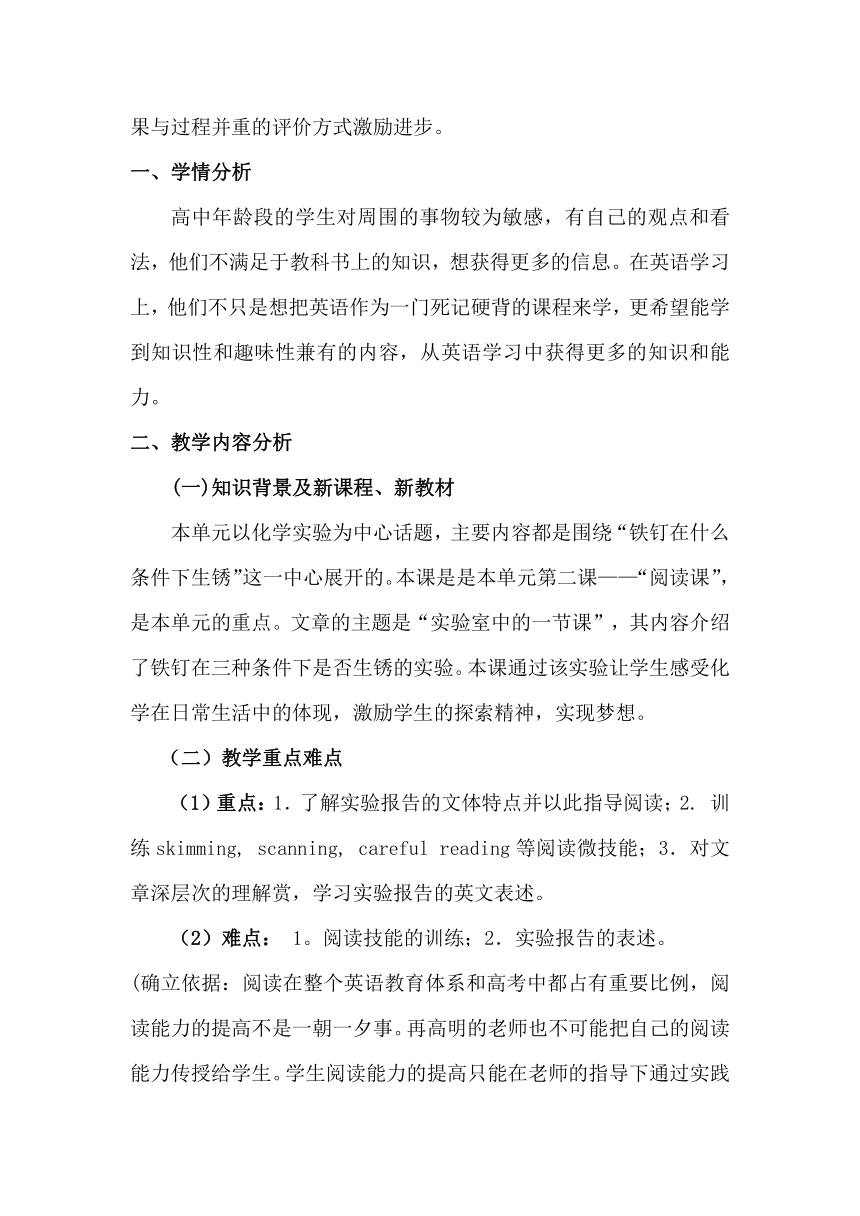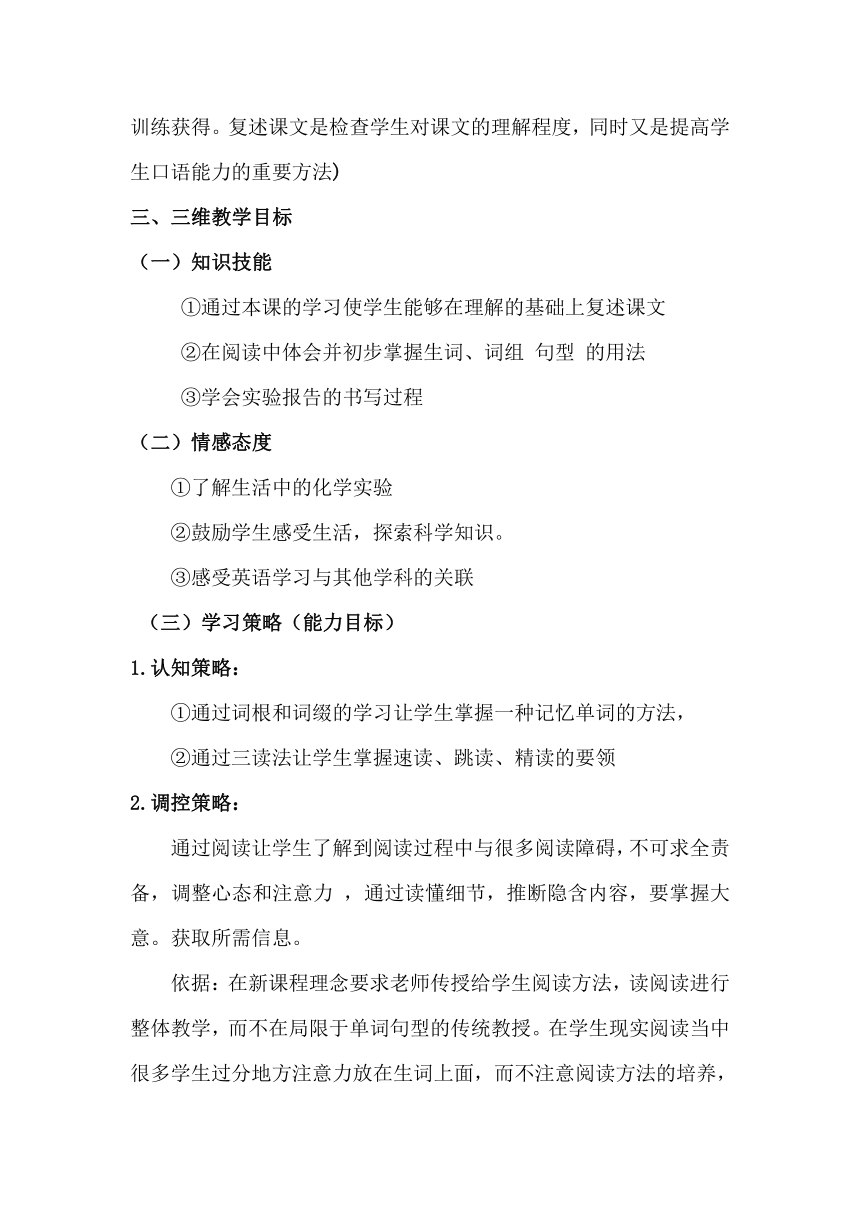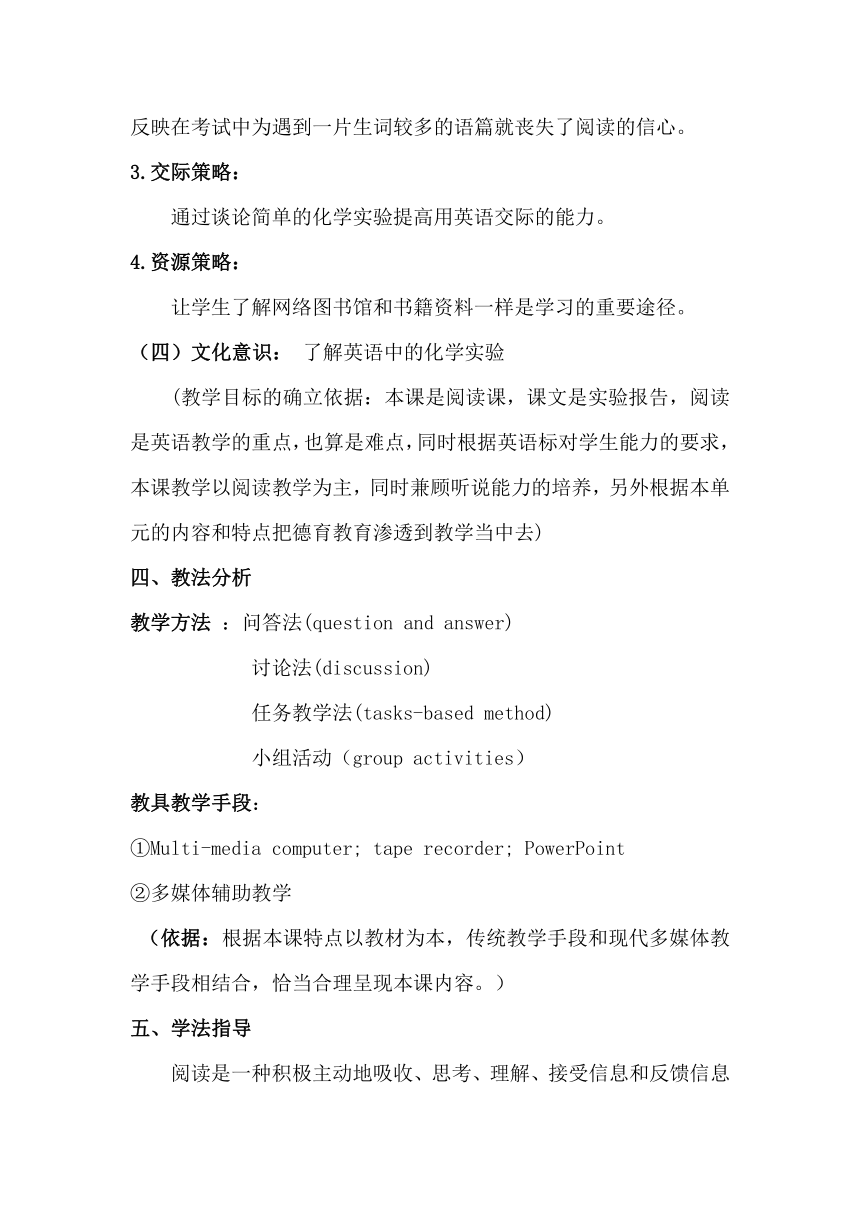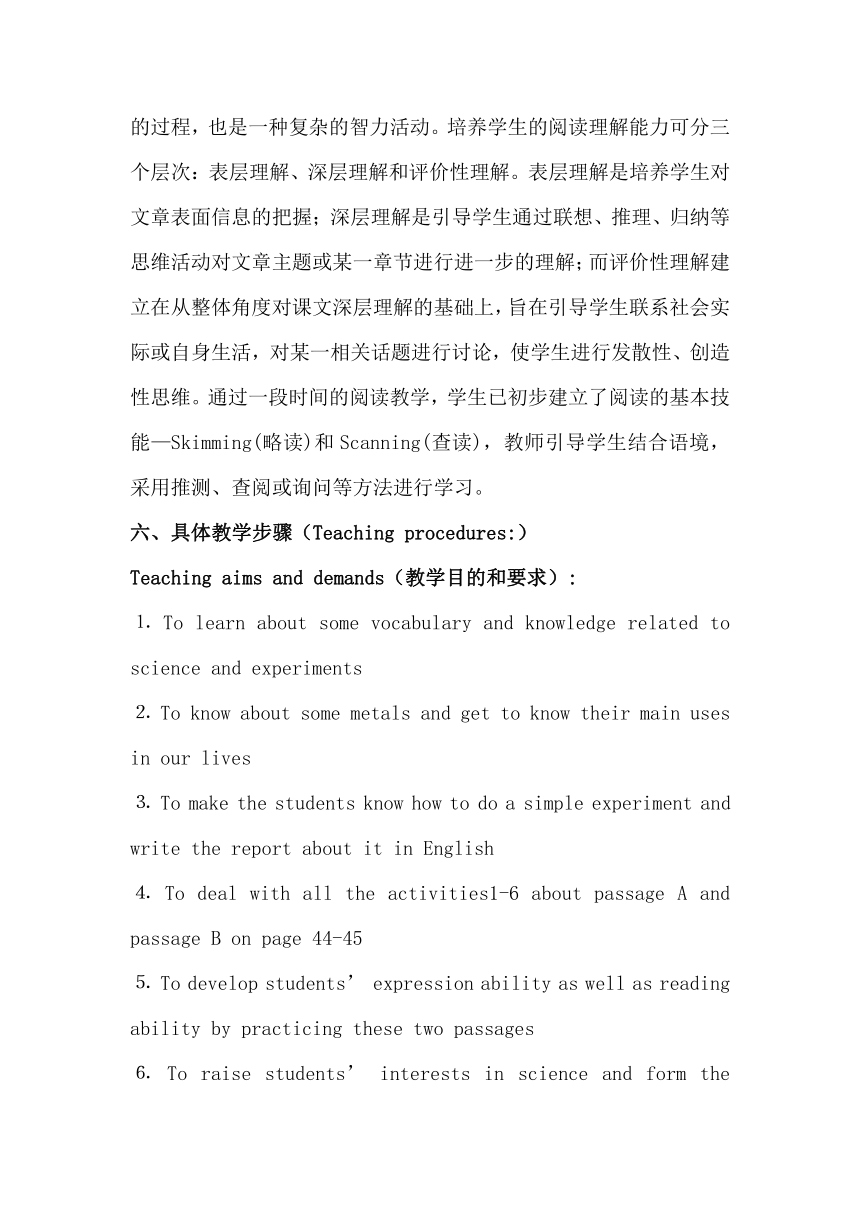Module 5 A lesson in a lab教案
文档属性
| 名称 | Module 5 A lesson in a lab教案 |  | |
| 格式 | zip | ||
| 文件大小 | 18.4KB | ||
| 资源类型 | 教案 | ||
| 版本资源 | 外研版 | ||
| 科目 | 英语 | ||
| 更新时间 | 2013-02-25 15:30:47 | ||
图片预览





文档简介
Module 5 A lesson in a lab
(第二课时阅读课 高一必修1)
引言
在英语教学中落实新课程标准,就是贯彻执行国家教育部关于课程改革的决定。新课程标准的三维教学观,结合我校三.五 .三课改理念的精神,具体到英语学科就是要整合发展学生语言技能、语言知识、情感态度、学习策略和文化意识五个方面的素养,培养学生综合运用语言的能力探究学习、合作学习、任务型学习是在新课程标准下实施素质教育的关键环节,所以在我的教学设计里,时时体现着这几种原则。
教学设计理念
1、运用任务型语言教学模式,训练培养学生对语言的综合运用,实现目标,感受成功,教学进度整体把握,教学形式不拘一格。
2、课堂以学生为主体,以任务为主线,重视体验参与,教师起到“设 计者、研究者、促进者、协调者”的作用。
3、在教学中,突出交际性,注重读写的实用性,要进行情感和策略 调整,以形成积极的学习态度,促进语言实际运用能力的提高。
4、课后访谈调查,读写摘记,重视语言运用。
5、正视个体差异,倡导过程激励,以多层次、多角度、多主体的结果与过程并重的评价方式激励进步。
一、学情分析
高中年龄段的学生对周围的事物较为敏感,有自己的观点和看法,他们不满足于教科书上的知识,想获得更多的信息。在英语学习上,他们不只是想把英语作为一门死记硬背的课程来学,更希望能学到知识性和趣味性兼有的内容,从英语学习中获得更多的知识和能力。
二、教学内容分析
(一)知识背景及新课程、新教材
本单元以化学实验为中心话题,主要内容都是围绕“铁钉在什么条件下生锈”这一中心展开的。本课是是本单元第二课——“阅读课”,是本单元的重点。文章的主题是“实验室中的一节课”,其内容介绍了铁钉在三种条件下是否生锈的实验。本课通过该实验让学生感受化学在日常生活中的体现,激励学生的探索精神,实现梦想。
(二)教学重点难点
(1)重点:1.了解实验报告的文体特点并以此指导阅读;2. 训练skimming, scanning, careful reading等阅读微技能;3.对文章深层次的理解赏,学习实验报告的英文表述。 (2)难点: 1。阅读技能的训练;2.实验报告的表述。
(确立依据:阅读在整个英语教育体系和高考中都占有重要比例,阅读能力的提高不是一朝一夕事。再高明的老师也不可能把自己的阅读能力传授给学生。学生阅读能力的提高只能在老师的指导下通过实践训练获得。复述课文是检查学生对课文的理解程度,同时又是提高学生口语能力的重要方法)
三、三维教学目标
(一)知识技能
①通过本课的学习使学生能够在理解的基础上复述课文
②在阅读中体会并初步掌握生词、词组 句型 的用法
③学会实验报告的书写过程
(二)情感态度
①了解生活中的化学实验
②鼓励学生感受生活,探索科学知识。
③感受英语学习与其他学科的关联
(三)学习策略(能力目标)
1.认知策略:
①通过词根和词缀的学习让学生掌握一种记忆单词的方法,
②通过三读法让学生掌握速读、跳读、精读的要领
2.调控策略:
通过阅读让学生了解到阅读过程中与很多阅读障碍,不可求全责备,调整心态和注意力 ,通过读懂细节,推断隐含内容,要掌握大意。获取所需信息。
依据:在新课程理念要求老师传授给学生阅读方法,读阅读进行整体教学,而不在局限于单词句型的传统教授。在学生现实阅读当中很多学生过分地方注意力放在生词上面,而不注意阅读方法的培养,反映在考试中为遇到一片生词较多的语篇就丧失了阅读的信心。
3.交际策略:
通过谈论简单的化学实验提高用英语交际的能力。
4.资源策略:
让学生了解网络图书馆和书籍资料一样是学习的重要途径。
(四)文化意识: 了解英语中的化学实验
(教学目标的确立依据:本课是阅读课,课文是实验报告,阅读是英语教学的重点,也算是难点,同时根据英语标对学生能力的要求,本课教学以阅读教学为主,同时兼顾听说能力的培养,另外根据本单元的内容和特点把德育教育渗透到教学当中去)
四、教法分析 教学方法 :问答法(question and answer)
讨论法(discussion)
任务教学法(tasks-based method)
小组活动(group activities)
教具教学手段:
①Multi-media computer; tape recorder; PowerPoint
②多媒体辅助教学
(依据:根据本课特点以教材为本,传统教学手段和现代多媒体教学手段相结合,恰当合理呈现本课内容。)
五、学法指导
阅读是一种积极主动地吸收、思考、理解、接受信息和反馈信息的过程,也是一种复杂的智力活动。培养学生的阅读理解能力可分三个层次:表层理解、深层理解和评价性理解。表层理解是培养学生对文章表面信息的把握;深层理解是引导学生通过联想、推理、归纳等思维活动对文章主题或某一章节进行进一步的理解;而评价性理解建立在从整体角度对课文深层理解的基础上,旨在引导学生联系社会实际或自身生活,对某一相关话题进行讨论,使学生进行发散性、创造性思维。通过一段时间的阅读教学,学生已初步建立了阅读的基本技能—Skimming(略读)和Scanning(查读),教师引导学生结合语境,采用推测、查阅或询问等方法进行学习。
六、具体教学步骤(Teaching procedures:)
Teaching aims and demands(教学目的和要求): ⒈ To learn about some vocabulary and knowledge related to science and experiments ⒉ To know about some metals and get to know their main uses in our lives ⒊ To make the students know how to do a simple experiment and write the report about it in English ⒋ To deal with all the activities1-6 about passage A and passage B on page 44-45 ⒌ To develop students’ expression ability as well as reading ability by practicing these two passages ⒍ To raise students’ interests in science and form the rigorous scientific attitude. Teaching key points(教学重点): ⒈ To make the students understand and grasp the vocabulary and knowledge related to science and experiments ⒉ To enable the students to know how to read some passages about simple scientific experiments Teaching difficulties(教学难点): To make students learn how to write an experiment report in English Teaching methods(教学方法): ⒈ Communicative approach ⒉ Task-based approach ⒊ Aural-oral approach with the help of the multi-media computer and the recorder
4.Group activities centered approach Teaching aids(教学辅助手段): Multi-media computer; Software; PowerPoint; Recorder Teaching procedures(教学流程): Step 1: Lead-in At first show the students the picture of a lab with the help of computer Then design the following questions and ask the students to discuss them in groups: 1. Are you interested in doing scientific experiments? 2. Suppose you want to do a chemical experiment about some metals, do you think it is necessary to know about how they react with other substances? 3. In order to carry out an experiment successfully, what should you prepare for it? This step is to warm up the students and raise their interests to speak English in class. Because all these questions are very close to the students’ daily life and studying Step 2:Pre-reading Teacher: Since you are interested in doing scientific experiments, now let’s get to know some vocabulary and knowledge related to science and experiments. At the same time I can type out some pictures about some metals on the screen with the help of the computer as follows: ⑴potassium(钾) ⑵sodium(钠) ⑶calcium(钙) ⑷magnesium(镁) ⑸aluminium(铝) ⑹zinc(锌) ⑺iron(铁) ⑻copper(铜) As I type out each of the above pictures, I can ask the students like this: What’s this? And what can it be used for? At this moment the students’ interests are probably approaching a climax. So I further ask them like this: Do you want to know more about these metals? And do you know how we can use these metals better? Well, this is what we’ll study very soon. This step is employed to create a language environment for students’ communication and arouse their interests in reading passage A and passage B on page 44-45 Step 3: Reading Passage A
T: Well, let’s read through passage A with the tape of it very quickly to try to catch its main idea. Then finish Activity 2 on page 44 and give your reasons. Next, ask the Ss to read passage A very carefully to find out the answers in Activity 3 on page 44. Finish this activity by multi-media computer. It can be designed as follows: 1. Which of the metals in the table reacts the most with oxygen and water? Potassium, calcium and sodium. 2. What happens when you heat calcium in oxygen? It burns to form an oxide. 3. Which metals react with steam? Magnesium, aluminium and zinc. 4. Does iron have a slow or fast reaction with steam? It has a slow reaction. 5. Does copper react with water? No, it doesn’t. Passage B T: Well, from passage A we can see how interesting the experiment about the reaction of metals is! But do you know how we can carry out a chemical experiment in a lab successfully? And what is the correct order to describe a scientific experiment? Ask the Ss to look at Activity 1 on page 44 and give them about 2 minutes to discuss it. Then collect the answers from them. At the same time type out the correct answer on the screen with the computer as follows: T: Now, let’s come to see “ A simple scientific experiment”!
Then play the tape of passage B for the students and ask them to read the passage with the tape quickly and finish Activity 4 on page 44. In order to lead the students to read the text very carefully, the following task-based questions can be signed to ask them to answer: ⑴Can you guess the meaning of the word “apparatus” through the context? Have you known all of the apparatuses of this experiment? ⑵In the second part of the experiment, why must you boil the water? And then why do you add some oil to the water? For Question 1, some students maybe feel strange to some apparatuses. If so , the following pictures can be typed out with the help of computer to help Ss to know about:
Then in order to make the Ss consolidate what they read in passage B and check if they have understood the experiment very well, Activity 5 on page 46 can be typed out on the screen with the help of computer as a task-based activity。 Step 4:Discussion ⒈Do you think it is easy or difficult for you to carry out a scientific experiment well? And can you describe how to do it successfully in simple words? ⒉If you want to learn science subjects well, what qualities do you think you should have? (Possible answers: We should be careful / serious / diligent /patient /thoughtful/ etc. ) This step is to consolidate what Ss have learnt in this lesson, in addition to penetrating the moral education to love science and form the rigorous scientific attitude. Homework
Since we have known about how to do a scientific experiment, please write a complete scientific experiment report in simple English?
Teaching summary(教学小结): ⒈We’ve learnt about some vocabulary and knowledge related to science and experiments
⒉We’ve finished studying passage A and passage B on page44-45.
⒊We’ve known how to carry out a scientific experiment in a lab successfully and write a complete scientific experiment report in simple English
七、教学时间分配
教育心理学指出新知识的学习需要一个接受的过程。本课是的内容是本单元的中心任务,所以阅读要用较多时间。
导入部分用2 分钟;
读前部分用6分钟;
读中部分用27分钟;
读后部分用8分钟;
最后用两分钟总结本课内容和布置作业。
八、课堂板书设计
将黑板划为左右两块,左边板书教学步骤,右边板书生词和短语。辅助阅读,扫除障碍。
六.教学反思
1.让学生明白学习目标,站在学生角度,精心设计活动。精心设计可操作性强的任务化活动是成功组织任务型教学的首要条件。这样学生可以通过完成具体的任务来学习和巩固语言,积累学习经验和享受成功的喜悦。
2.本堂课使用多媒体教学,能够调动学生英语学习的积极性,为学生创设了良好的英语交际环境。
3.课堂设计合理,结构流畅,成功的达到教学目标。教师不仅是知识的传授者,还成为学生学习的促进者、指导者、组织者、帮助者、参与者和合作者,除了传授学生必要的语言知识外,还重视学生的个性和兴趣。在这堂课中,教师通过多媒体技术,为学生创设各种语言学习环境,提供丰富的教学资源,拓宽了学生的学习渠道和学习方式。
4.以任务型为教学原则,本案例的每一个任务都是围绕学习者“学”的角度设计的。通过小组活动,培养合作探究能力。学生的每一个活动都具有明确的目的指向和具体的操作要求,实现了英语在真实情境中的应用。
总之,本课以学生为主体、任务型教学主线,合作教学为原则,以多媒体为教学手段,突出交际性,重视读写的实用性,重视学习策略的培养、重视个体差异和结果与过程并重的评价方式。通过合作、探究,运用“三读法”让学生由表及里、由浅入深的进行表层理解、深层理解、评价性理解,培养学生阅读能力的同时,培养学生的听说写的能力。经过授课达到了预期的授课效果。
Module 5 A lesson in a lab
(第二课时阅读课 高一必修1)
引言
在英语教学中落实新课程标准,就是贯彻执行国家教育部关于课程改革的决定。新课程标准的三维教学观,结合我校三.五 .三课改理念的精神,具体到英语学科就是要整合发展学生语言技能、语言知识、情感态度、学习策略和文化意识五个方面的素养,培养学生综合运用语言的能力探究学习、合作学习、任务型学习是在新课程标准下实施素质教育的关键环节,所以在我的教学设计里,时时体现着这几种原则。
教学设计理念
1、运用任务型语言教学模式,训练培养学生对语言的综合运用,实现目标,感受成功,教学进度整体把握,教学形式不拘一格。
2、课堂以学生为主体,以任务为主线,重视体验参与,教师起到“设 计者、研究者、促进者、协调者”的作用。
3、在教学中,突出交际性,注重读写的实用性,要进行情感和策略 调整,以形成积极的学习态度,促进语言实际运用能力的提高。
4、课后访谈调查,读写摘记,重视语言运用。
5、正视个体差异,倡导过程激励,以多层次、多角度、多主体的结果与过程并重的评价方式激励进步。
一、学情分析
高中年龄段的学生对周围的事物较为敏感,有自己的观点和看法,他们不满足于教科书上的知识,想获得更多的信息。在英语学习上,他们不只是想把英语作为一门死记硬背的课程来学,更希望能学到知识性和趣味性兼有的内容,从英语学习中获得更多的知识和能力。
二、教学内容分析
(一)知识背景及新课程、新教材
本单元以化学实验为中心话题,主要内容都是围绕“铁钉在什么条件下生锈”这一中心展开的。本课是是本单元第二课——“阅读课”,是本单元的重点。文章的主题是“实验室中的一节课”,其内容介绍了铁钉在三种条件下是否生锈的实验。本课通过该实验让学生感受化学在日常生活中的体现,激励学生的探索精神,实现梦想。
(二)教学重点难点
(1)重点:1.了解实验报告的文体特点并以此指导阅读;2. 训练skimming, scanning, careful reading等阅读微技能;3.对文章深层次的理解赏,学习实验报告的英文表述。 (2)难点: 1。阅读技能的训练;2.实验报告的表述。
(确立依据:阅读在整个英语教育体系和高考中都占有重要比例,阅读能力的提高不是一朝一夕事。再高明的老师也不可能把自己的阅读能力传授给学生。学生阅读能力的提高只能在老师的指导下通过实践训练获得。复述课文是检查学生对课文的理解程度,同时又是提高学生口语能力的重要方法)
三、三维教学目标
(一)知识技能
①通过本课的学习使学生能够在理解的基础上复述课文
②在阅读中体会并初步掌握生词、词组 句型 的用法
③学会实验报告的书写过程
(二)情感态度
①了解生活中的化学实验
②鼓励学生感受生活,探索科学知识。
③感受英语学习与其他学科的关联
(三)学习策略(能力目标)
1.认知策略:
①通过词根和词缀的学习让学生掌握一种记忆单词的方法,
②通过三读法让学生掌握速读、跳读、精读的要领
2.调控策略:
通过阅读让学生了解到阅读过程中与很多阅读障碍,不可求全责备,调整心态和注意力 ,通过读懂细节,推断隐含内容,要掌握大意。获取所需信息。
依据:在新课程理念要求老师传授给学生阅读方法,读阅读进行整体教学,而不在局限于单词句型的传统教授。在学生现实阅读当中很多学生过分地方注意力放在生词上面,而不注意阅读方法的培养,反映在考试中为遇到一片生词较多的语篇就丧失了阅读的信心。
3.交际策略:
通过谈论简单的化学实验提高用英语交际的能力。
4.资源策略:
让学生了解网络图书馆和书籍资料一样是学习的重要途径。
(四)文化意识: 了解英语中的化学实验
(教学目标的确立依据:本课是阅读课,课文是实验报告,阅读是英语教学的重点,也算是难点,同时根据英语标对学生能力的要求,本课教学以阅读教学为主,同时兼顾听说能力的培养,另外根据本单元的内容和特点把德育教育渗透到教学当中去)
四、教法分析 教学方法 :问答法(question and answer)
讨论法(discussion)
任务教学法(tasks-based method)
小组活动(group activities)
教具教学手段:
①Multi-media computer; tape recorder; PowerPoint
②多媒体辅助教学
(依据:根据本课特点以教材为本,传统教学手段和现代多媒体教学手段相结合,恰当合理呈现本课内容。)
五、学法指导
阅读是一种积极主动地吸收、思考、理解、接受信息和反馈信息的过程,也是一种复杂的智力活动。培养学生的阅读理解能力可分三个层次:表层理解、深层理解和评价性理解。表层理解是培养学生对文章表面信息的把握;深层理解是引导学生通过联想、推理、归纳等思维活动对文章主题或某一章节进行进一步的理解;而评价性理解建立在从整体角度对课文深层理解的基础上,旨在引导学生联系社会实际或自身生活,对某一相关话题进行讨论,使学生进行发散性、创造性思维。通过一段时间的阅读教学,学生已初步建立了阅读的基本技能—Skimming(略读)和Scanning(查读),教师引导学生结合语境,采用推测、查阅或询问等方法进行学习。
六、具体教学步骤(Teaching procedures:)
Teaching aims and demands(教学目的和要求): ⒈ To learn about some vocabulary and knowledge related to science and experiments ⒉ To know about some metals and get to know their main uses in our lives ⒊ To make the students know how to do a simple experiment and write the report about it in English ⒋ To deal with all the activities1-6 about passage A and passage B on page 44-45 ⒌ To develop students’ expression ability as well as reading ability by practicing these two passages ⒍ To raise students’ interests in science and form the rigorous scientific attitude. Teaching key points(教学重点): ⒈ To make the students understand and grasp the vocabulary and knowledge related to science and experiments ⒉ To enable the students to know how to read some passages about simple scientific experiments Teaching difficulties(教学难点): To make students learn how to write an experiment report in English Teaching methods(教学方法): ⒈ Communicative approach ⒉ Task-based approach ⒊ Aural-oral approach with the help of the multi-media computer and the recorder
4.Group activities centered approach Teaching aids(教学辅助手段): Multi-media computer; Software; PowerPoint; Recorder Teaching procedures(教学流程): Step 1: Lead-in At first show the students the picture of a lab with the help of computer Then design the following questions and ask the students to discuss them in groups: 1. Are you interested in doing scientific experiments? 2. Suppose you want to do a chemical experiment about some metals, do you think it is necessary to know about how they react with other substances? 3. In order to carry out an experiment successfully, what should you prepare for it? This step is to warm up the students and raise their interests to speak English in class. Because all these questions are very close to the students’ daily life and studying Step 2:Pre-reading Teacher: Since you are interested in doing scientific experiments, now let’s get to know some vocabulary and knowledge related to science and experiments. At the same time I can type out some pictures about some metals on the screen with the help of the computer as follows: ⑴potassium(钾) ⑵sodium(钠) ⑶calcium(钙) ⑷magnesium(镁) ⑸aluminium(铝) ⑹zinc(锌) ⑺iron(铁) ⑻copper(铜) As I type out each of the above pictures, I can ask the students like this: What’s this? And what can it be used for? At this moment the students’ interests are probably approaching a climax. So I further ask them like this: Do you want to know more about these metals? And do you know how we can use these metals better? Well, this is what we’ll study very soon. This step is employed to create a language environment for students’ communication and arouse their interests in reading passage A and passage B on page 44-45 Step 3: Reading Passage A
T: Well, let’s read through passage A with the tape of it very quickly to try to catch its main idea. Then finish Activity 2 on page 44 and give your reasons. Next, ask the Ss to read passage A very carefully to find out the answers in Activity 3 on page 44. Finish this activity by multi-media computer. It can be designed as follows: 1. Which of the metals in the table reacts the most with oxygen and water? Potassium, calcium and sodium. 2. What happens when you heat calcium in oxygen? It burns to form an oxide. 3. Which metals react with steam? Magnesium, aluminium and zinc. 4. Does iron have a slow or fast reaction with steam? It has a slow reaction. 5. Does copper react with water? No, it doesn’t. Passage B T: Well, from passage A we can see how interesting the experiment about the reaction of metals is! But do you know how we can carry out a chemical experiment in a lab successfully? And what is the correct order to describe a scientific experiment? Ask the Ss to look at Activity 1 on page 44 and give them about 2 minutes to discuss it. Then collect the answers from them. At the same time type out the correct answer on the screen with the computer as follows: T: Now, let’s come to see “ A simple scientific experiment”!
Then play the tape of passage B for the students and ask them to read the passage with the tape quickly and finish Activity 4 on page 44. In order to lead the students to read the text very carefully, the following task-based questions can be signed to ask them to answer: ⑴Can you guess the meaning of the word “apparatus” through the context? Have you known all of the apparatuses of this experiment? ⑵In the second part of the experiment, why must you boil the water? And then why do you add some oil to the water? For Question 1, some students maybe feel strange to some apparatuses. If so , the following pictures can be typed out with the help of computer to help Ss to know about:
Then in order to make the Ss consolidate what they read in passage B and check if they have understood the experiment very well, Activity 5 on page 46 can be typed out on the screen with the help of computer as a task-based activity。 Step 4:Discussion ⒈Do you think it is easy or difficult for you to carry out a scientific experiment well? And can you describe how to do it successfully in simple words? ⒉If you want to learn science subjects well, what qualities do you think you should have? (Possible answers: We should be careful / serious / diligent /patient /thoughtful/ etc. ) This step is to consolidate what Ss have learnt in this lesson, in addition to penetrating the moral education to love science and form the rigorous scientific attitude. Homework
Since we have known about how to do a scientific experiment, please write a complete scientific experiment report in simple English?
Teaching summary(教学小结): ⒈We’ve learnt about some vocabulary and knowledge related to science and experiments
⒉We’ve finished studying passage A and passage B on page44-45.
⒊We’ve known how to carry out a scientific experiment in a lab successfully and write a complete scientific experiment report in simple English
七、教学时间分配
教育心理学指出新知识的学习需要一个接受的过程。本课是的内容是本单元的中心任务,所以阅读要用较多时间。
导入部分用2 分钟;
读前部分用6分钟;
读中部分用27分钟;
读后部分用8分钟;
最后用两分钟总结本课内容和布置作业。
八、课堂板书设计
将黑板划为左右两块,左边板书教学步骤,右边板书生词和短语。辅助阅读,扫除障碍。
六.教学反思
1.让学生明白学习目标,站在学生角度,精心设计活动。精心设计可操作性强的任务化活动是成功组织任务型教学的首要条件。这样学生可以通过完成具体的任务来学习和巩固语言,积累学习经验和享受成功的喜悦。
2.本堂课使用多媒体教学,能够调动学生英语学习的积极性,为学生创设了良好的英语交际环境。
3.课堂设计合理,结构流畅,成功的达到教学目标。教师不仅是知识的传授者,还成为学生学习的促进者、指导者、组织者、帮助者、参与者和合作者,除了传授学生必要的语言知识外,还重视学生的个性和兴趣。在这堂课中,教师通过多媒体技术,为学生创设各种语言学习环境,提供丰富的教学资源,拓宽了学生的学习渠道和学习方式。
4.以任务型为教学原则,本案例的每一个任务都是围绕学习者“学”的角度设计的。通过小组活动,培养合作探究能力。学生的每一个活动都具有明确的目的指向和具体的操作要求,实现了英语在真实情境中的应用。
总之,本课以学生为主体、任务型教学主线,合作教学为原则,以多媒体为教学手段,突出交际性,重视读写的实用性,重视学习策略的培养、重视个体差异和结果与过程并重的评价方式。通过合作、探究,运用“三读法”让学生由表及里、由浅入深的进行表层理解、深层理解、评价性理解,培养学生阅读能力的同时,培养学生的听说写的能力。经过授课达到了预期的授课效果。
